Behavioral Conditioning in Cognitive Behavioral Therapy
Cognitive Behavioral Therapy (CBT) remains one of the most empirically supported and adaptable approaches in modern psychotherapy. Emerging from the fusion of behavioral learning theory and cognitive science, CBT provides an evidence-based framework for understanding how thoughts, emotions, and behaviors interconnect (Beck, 2011). While the “cognitive” component addresses the interpretation of experience, its behavioral foundations—rooted in classical and operant conditioning—explain how emotional responses and habits are learned, reinforced, and transformed.
This article explores how behavioural conditioning functions within CBT: how it shapes emotional learning, how therapists help clients unlearn maladaptive patterns, and how conditioning principles can be consciously re-applied to foster growth and resilience.
Behavioral Conditioning in Cognitive Behavioral Therapy Read article













